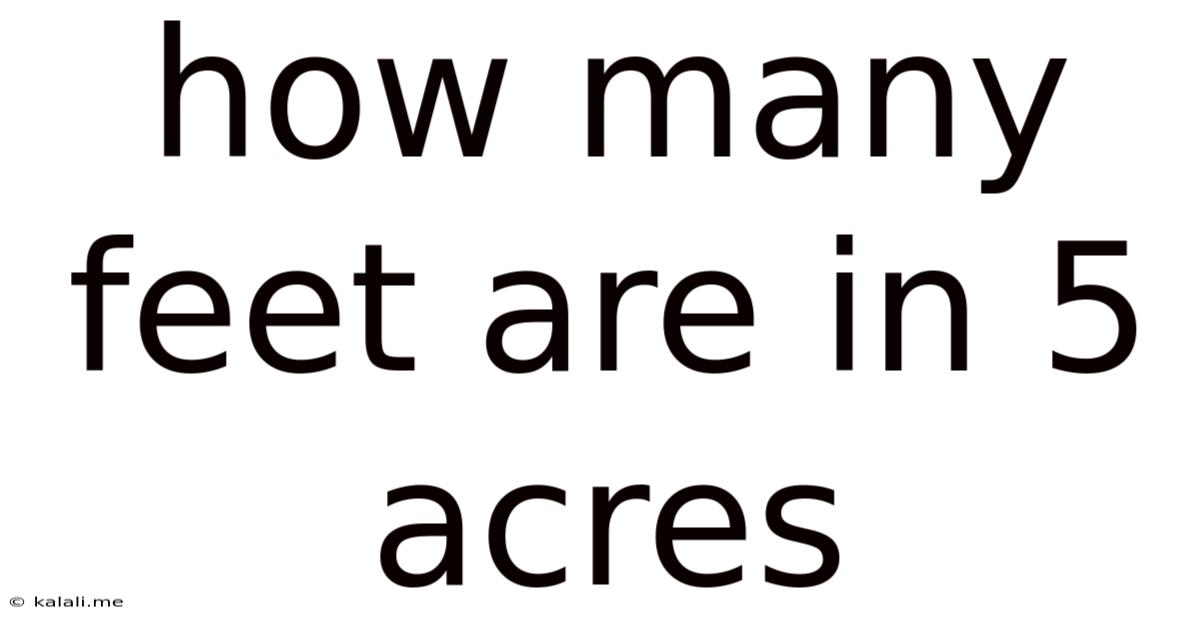How Many Feet Are In 5 Acres
Kalali
Aug 25, 2025 · 4 min read

Table of Contents
How Many Feet Are in 5 Acres? Understanding Land Measurement Conversions
This article delves into the complexities of land measurement, specifically addressing the question: how many feet are there in 5 acres? While it might seem like a simple conversion, understanding the underlying principles of area calculation and the relationship between different units is crucial. We'll not only provide the answer but also explore the practical applications of this knowledge, covering various scenarios where such conversions are necessary. This guide will be especially useful for real estate agents, land surveyors, construction professionals, and anyone dealing with property measurements.
Understanding Acres and Feet: A Foundation for Conversion
Before we dive into the calculation, let's clarify the units involved. An acre is a unit of land area, traditionally defined as the area of one chain by one furlong (66 feet by 660 feet). This translates to 43,560 square feet. A foot, on the other hand, is a unit of linear measurement, representing 1/3 of a yard. The key difference is that acres measure area (two dimensions), while feet measure length (one dimension). Therefore, directly converting acres to feet requires a nuanced approach. We are essentially trying to figure out the total linear distance represented within the 5-acre area, a concept that requires a defined shape for accurate calculations.
Calculating the Linear Dimensions of a 5-Acre Parcel
The crucial factor in converting acres to feet is the shape of the land. A 5-acre plot could be a square, a rectangle, a triangle, or any irregular polygon. Each shape will yield different linear measurements, even though the area remains constant. To illustrate, let's consider a few scenarios:
1. A Square 5-Acre Plot:
- Area: 5 acres = 5 * 43,560 square feet = 217,800 square feet
- Side Length: To find the side length of a square, we take the square root of the area: √217,800 ≈ 466.7 feet.
- Perimeter: The perimeter of a square is 4 times the side length: 4 * 466.7 ≈ 1866.8 feet. This represents the total linear distance around the square plot.
2. A Rectangular 5-Acre Plot:
The calculations for a rectangle require knowing at least one dimension. Let's assume a rectangle with a length twice its width:
- Area: 217,800 square feet
- Let's say width (w) = x: Then the length (l) = 2x.
- Area Formula: l * w = 217,800 => 2x * x = 217,800 => 2x² = 217,800 => x² = 108,900 => x ≈ 330 feet (width)
- Length: l = 2x ≈ 660 feet
- Perimeter: 2(l + w) = 2(660 + 330) = 1980 feet.
Note that the perimeter (total linear distance around the rectangle) differs from the square example, highlighting the influence of shape.
3. Irregularly Shaped 5-Acre Plots:
For irregular shapes, the calculations become more complex. You'd need to employ techniques like surveying or GIS (Geographic Information Systems) to determine the precise boundaries and then use advanced mathematical methods (like dividing the irregular area into smaller, manageable shapes) to calculate the total perimeter or any specific linear dimensions.
Practical Applications and Considerations
Understanding the conversion between acres and feet is vital in numerous real-world scenarios:
-
Real Estate: Determining the dimensions of a property is fundamental in real estate transactions. Knowing the linear boundaries is crucial for accurate property descriptions and legal compliance.
-
Construction and Development: Construction projects necessitate precise measurements. Converting acreage to linear feet is essential for planning site layouts, determining material quantities, and calculating costs. For example, fencing, road construction, or utility line installation all require accurate linear measurements derived from the total acreage.
-
Agriculture and Farming: Farmers often need to know the linear dimensions of their fields for efficient planting, irrigation, and harvesting. This helps optimize resource allocation and maximize yields.
-
Environmental Studies: Calculating linear distances within a given acreage is crucial for ecological studies, habitat mapping, and conservation efforts.
-
Land Surveying: Land surveyors routinely perform these conversions to create accurate maps and property plans. They utilize sophisticated equipment and software to measure and represent land in different units.
Beyond Linear Feet: Other Relevant Conversions
While this article focuses on converting acres to feet, understanding related conversions enhances your comprehension of land measurement:
- Acres to Square Yards: 1 acre = 4840 square yards.
- Acres to Square Meters: 1 acre ≈ 4047 square meters.
- Acres to Hectares: 1 acre ≈ 0.4047 hectares.
- Feet to Meters: 1 foot ≈ 0.3048 meters.
- Feet to Yards: 1 yard = 3 feet.
Conclusion: The Importance of Context and Precision
The question "How many feet are in 5 acres?" doesn't have a single definitive answer without knowing the shape of the land. While the area remains constant at 217,800 square feet, the total linear distance within that area varies drastically depending on the shape. Accurate conversion necessitates considering the specific geometry of the land parcel. For irregular shapes, professional surveying is often required to get precise linear measurements. This understanding is crucial for anyone working with land measurements, ensuring accurate calculations and informed decision-making. Remember to always consider the context and strive for precision when dealing with land measurements, as even slight inaccuracies can have significant consequences.
Latest Posts
Latest Posts
-
How Tall Is A Ten Story Building
Aug 25, 2025
-
6 Divided By 9 As A Fraction
Aug 25, 2025
-
How Many Times Can 8 Go Into 70
Aug 25, 2025
-
How Much Is A Tortie Cat Worth
Aug 25, 2025
-
How Long Is A 25 Mile Drive
Aug 25, 2025
Related Post
Thank you for visiting our website which covers about How Many Feet Are In 5 Acres . We hope the information provided has been useful to you. Feel free to contact us if you have any questions or need further assistance. See you next time and don't miss to bookmark.